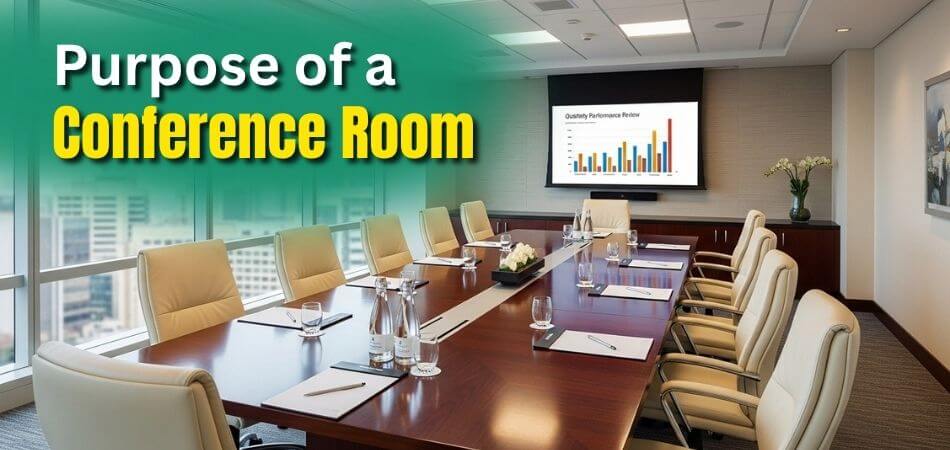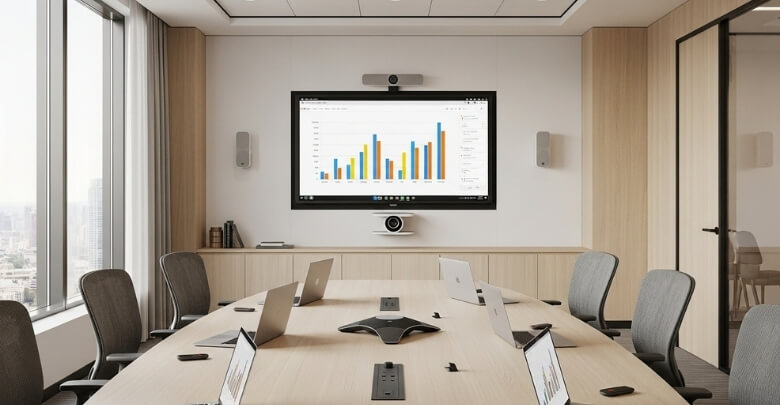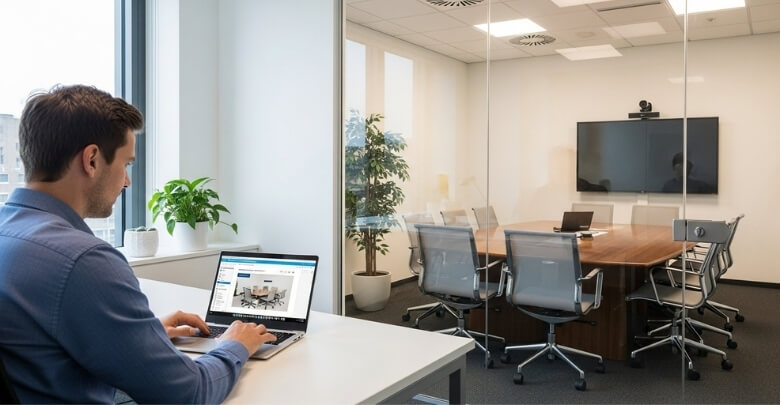A conference room is more than just four walls and a table—it’s a space designed to bring people together. It provides a quiet, distraction-free environment where teams can collaborate, share ideas, and plan effectively. Whether for brainstorming sessions, presentations, or client meetings, it plays a vital role in keeping work organized and professional.
So, what is the purpose of a conference room?
Simply put, it serves as a dedicated place for teamwork, problem-solving, and building stronger connections. It also helps create a positive impression on clients and boosts overall productivity by giving discussions the structure they need.
Keep reading as we explore the full benefits and reasons why a well-designed conference room is essential in any workplace.
What is the Purpose of a Conference Room?
A conference room is a dedicated space where people gather to discuss ideas, plan projects, and collaborate effectively. It provides privacy for sensitive topics while offering the right environment for training, presentations, and professional meetings. Equipped with modern tools, it supports productivity and strengthens communication. Below are key reasons conference rooms matter in business.

Privacy and Focus
Conference rooms ensure conversations remain private, shielding sensitive information from distractions and external interruptions during important discussions. This privacy fosters trust, allowing participants to communicate openly about delicate issues without concern for confidentiality breaches.
It also creates an environment where concentration thrives, enabling effective decisions in a calm, controlled space. In today’s workplaces, privacy and focus remain critical for ensuring both productivity and business integrity during every meeting.
Collaboration
Collaboration becomes smoother when teams meet in a conference room designed to encourage face-to-face engagement and connection. Members exchange ideas freely, brainstorm solutions, and collectively address challenges that may otherwise hinder overall progress within the organization.
These discussions strengthen relationships and allow creativity to flourish, ultimately inspiring innovative solutions for shared goals. Whether for project planning or upcoming conferences, a conference room makes collaborative efforts more effective and meaningful.
Training and Presentations
Conference rooms provide professional settings ideal for training employees, hosting workshops, and showcasing products or services to clients. The structured environment keeps participants attentive while technology tools enhance delivery and support clearer communication.
Visual aids, interactive presentations, and flexible setups help ensure learning sessions are engaging and productive. By offering this adaptability, conference rooms empower businesses to grow stronger through skilled teams and improved knowledge-sharing experiences.
Professionalism
Meeting in a conference room projects professionalism, leaving a strong impression on clients, investors, and partners alike. A formal, well-equipped space demonstrates commitment to organization and attention to detail, reinforcing credibility for every interaction.
Such an atmosphere elevates confidence, making participants feel valued and respected during important discussions. In turn, this professional setting encourages stronger partnerships and promotes business growth through trust and reliability.
Productivity and Flexibility
Conference rooms enhance productivity by offering technology, resources, and adaptable layouts tailored to specific meeting needs. This flexibility supports everything from small team huddles to large presentations, ensuring efficiency and comfort for participants.
Equipped with tools like screens, projectors, and video conferencing, meetings run smoothly and achieve goals faster. Organizations gain measurable benefits, as streamlined communication in conference rooms leads to improved decision-making and sustained business momentum.
How to Design a Conference Room for Productive Meetings?
Designing a conference room for productive meetings involves creating a flexible, comfortable, and technologically equipped space that encourages collaboration, focus, and efficient communication. Here are key design principles to boost meeting productivity:
Flexible Layouts
Design the room with adaptable seating arrangements to accommodate various types of meetings, such as brainstorming sessions, presentations, or team discussions. Instead of a fixed boardroom style, consider U-shaped, circular, or lounge-style setups that foster interaction and openness.
Technology Integration
Equip the room with modern technology, including large display screens, video conferencing systems, wireless connectivity, and user-friendly control interfaces. This supports seamless sharing of presentations, real-time document collaboration, and remote participation, minimizing technical disruptions.
Comfortable Environment
Prioritize ergonomic and comfortable furniture with adequate spacing for each participant. Incorporate natural lighting, plants, and good ventilation to create an inviting atmosphere that helps maintain focus during longer meetings. Proper acoustics with sound-absorbing materials reduce distractions from echoes or external noise.
Writing and Collaboration Tools
Integrate writable surfaces such as whiteboards, chalkboards, or writable walls to encourage visual thinking and active participation. These tools are essential for brainstorming and problem-solving.
Space Optimization
Size the room appropriately based on typical meeting attendance, providing enough clearance for free movement around tables and chairs. A good rule is to allow at least 48 inches of clearance around tables, supporting comfort and accessibility.
Additional Enhancements
Consider adding a refreshment station to keep participants energized, using modular furniture for quick reconfiguration, and incorporating sustainable materials and energy-efficient lighting for an eco-friendly workspace.
What Tech Equipment is Essential in a Conference Room?
A conference room works best when it has the right technology. Good tools make it easier to share ideas, talk clearly, and stay connected. They also help both in-person and online teams work together without stress. Here are the must-have tech tools for any conference room.
Display System
- Big screens or projectors show slides, videos, and charts so everyone can follow along. This makes it simple to share information and keep the group focused.
- Presenters can move between images, charts, and live demos without slowing the meeting. The switch is smooth and keeps people interested.
Video Conferencing Camera
- A good camera shows clear pictures so remote teammates feel included in the discussion. It helps create a real connection.
- Wide angles and sharp views capture everyone, making online meetings feel closer to face-to-face conversations.
Audio System
- Strong microphones and speakers make voices sound clear, so no one misses important details. Everyone gets a chance to be heard.
- Noise filters block background sounds that can distract or confuse people during serious talks. This helps meetings stay focused.
Internet Connectivity
- Fast internet keeps video calls and shared files running smoothly without delays. It supports better teamwork online.
- A strong connection also reduces stress, since participants can rely on tools working during presentations and discussions.
Cabling and Adapters
- Different cables and adapters connect laptops or phones to big screens for easy sharing. Switching presenters becomes simple.
- Reliable wiring keeps presentations from breaking down or causing delays. This ensures meetings stay on track.
Room Scheduling Display
- Small digital screens outside meeting rooms show if the room is free or booked. This saves time and avoids mix-ups.
- Teams can quickly check and confirm their schedules, aligning perfectly with the overall conference room purpose of keeping meetings organized.
Collaboration Tools
- Whiteboards and smart boards let teams brainstorm together. They make it easier to share ideas visually.
- Digital tools can save notes and share them after meetings. This helps teams act on ideas later.
Power Outlets and Charging Stations
- Charging points around the table keep laptops and phones powered all day. No meeting has to stop.
- Organized outlets reduce messy cables on the floor. Cleaner spaces make working together easier and more comfortable.
Lighting Controls
- Adjustable lights set the right brightness for talking, presenting, or long work sessions. They help people stay alert.
- Clear lighting also makes screens easier to see. This improves understanding and keeps attention on the presentation.
How to Choose the Right Conference Room Size for Teams?
Choosing the right conference room size matters more than people think. A room that feels too small feels crowded and uncomfortable. A space too large wastes resources and lowers energy. The perfect size depends on team needs, meeting styles, and future growth. Here are the key factors to consider when picking the right size.
- Know Team Size: Count how many people usually join meetings, then pick a room that fits slightly more to allow flexibility comfortably.
- Check Meeting Style: Workshops need open layouts with space for activities, while formal presentations require seating arrangements facing displays and presenters clearly.
- Plan for Growth: Teams often expand over time, so choose a room slightly larger to accommodate new hires without overcrowding situations.
- Think About Equipment: Screens, cameras, and tables take space, so factor them in when choosing room size to avoid unexpected discomfort.
- Focus on Comfort: Chairs with proper spacing and walking areas reduce stress, keeping everyone engaged longer without feeling trapped or distracted.
- Look at Duration: Longer meetings need more breathing space with good ventilation, while shorter sessions can manage with smaller, cozier rooms.
- Consider Flexibility: Movable furniture and adaptable layouts make rooms useful for different purposes, from brainstorming sessions to official client presentations effectively.
- Check Room Location: Conveniently located rooms save time and improve attendance, ensuring meetings start on time and flow without wasted energy.
- Assess Future Needs: Consider technology upgrades, upcoming tools, or larger projects before finalizing room size, preventing future redesigns or unnecessary adjustments.
Best Practices for Booking and Managing Conference Rooms
Booking and managing a conference room may sound simple, but it can turn tricky without proper planning. Many times, rooms get double-booked or left unused, causing unnecessary stress. A little effort can make everything smoother and more efficient for everyone. Knowing these smart tips helps avoid confusion and saves time.
Clear Scheduling
Always keep a calendar that shows when the room is free and when it’s booked. This avoids clashes and confusion. People can quickly check the schedule before planning their meetings. A shared system ensures everyone gets equal access and no one is left out.
Plan Ahead
It’s always better to book the room before the actual day of the meeting. Waiting until the last minute creates problems. Early booking gives you time to prepare the setup. It also makes sure the space is available when you need it most.
Right Timing
Meetings often take longer than expected, so it’s smart to allow some extra minutes. Don’t book back-to-back meetings. Give space between sessions for cleaning and rearranging. This small step makes everything run smoothly without people feeling rushed or uncomfortable.
Use Tech Tools
Many offices use apps or online systems to make booking simple and fast. These tools show availability in real time. They can also send reminders about upcoming meetings. With technology, different conference room setups can be managed more easily for both small and large teams.
Respect Others
When using the room, finish on time so the next group can start without waiting. Leaving the room clean shows respect. Don’t take longer than your slot unless you extend it officially. Remember, the space belongs to everyone, not just one team.
Arrange Properly
Every meeting has different needs, so arrange the furniture and equipment before people arrive. This saves time during the meeting. Having chairs, screens, or projectors ready helps everyone focus on the discussion. A little effort makes the meeting feel organized from the start.
Keep Track
It’s helpful to review how often the conference room is used. If it’s always full, maybe more space is needed. If it’s often empty, booking rules might need to change. Keeping track helps the office run smoothly and avoids wasted space.
Frequently Asked Questions About the Purpose of a Conference Room
A conference room plays a key role in how teams work and connect every day. It creates a space where ideas flow, decisions are made, and business grows. Below are some common questions people ask about its real purpose.
Why Is A Conference Room Important For Businesses?
A conference room provides a private space where teams can communicate clearly, share ideas, and build strategies. It supports professional discussions, creates a strong impression on clients, and helps businesses maintain focus without distractions, boosting productivity and collaboration effectively.
How Do Conference Rooms Support Decision-Making?
Conference rooms allow leaders and teams to gather, analyze issues, and discuss solutions in one focused place. They reduce misunderstandings, encourage active participation, and provide tools like screens or whiteboards that make information clear, leading to smarter and quicker business decisions.
What Role Do Conference Rooms Play In Client Meetings?
Conference rooms provide a professional environment where businesses can present confidently to clients, partners, or investors. The organized setup builds trust, shows reliability, and leaves a positive impression. This makes clients feel valued while strengthening long-term business relationships and opportunities.
How Do Conference Rooms Improve Team Creativity?
Conference rooms encourage brainstorming sessions by giving people space to share fresh ideas openly. Tools like whiteboards or smart boards help visualize thoughts. With fewer distractions, teams can focus better, explore solutions creatively, and work together toward innovative strategies and outcomes.
Why Do Conference Rooms Enhance Productivity?
A conference room minimizes workplace distractions, allowing people to concentrate only on the discussion at hand. With proper equipment, meetings run smoothly and save time. Focused communication and organized planning inside this space directly increase team productivity and efficiency overall.
How Do Conference Rooms Provide Flexibility?
Conference rooms can adapt to different meeting types, from small group discussions to large presentations. With movable furniture and integrated technology, they adjust easily. This flexibility supports diverse needs, making them valuable for every business function, training, or team session.
What Is The Connection Between Conference Rooms And Professionalism?
Conference rooms reflect the company’s seriousness and values. A neat, well-equipped space signals respect for attendees’ time and effort. This environment builds trust with clients and employees, showing that the business operates with organization, commitment, and attention to detail.
How Do Conference Rooms Help With Privacy?
Conference rooms create private spaces where sensitive discussions can happen without distractions. This ensures confidentiality in topics like finances, strategies, or client matters. By providing privacy, they support honest communication, strengthen trust among participants, and protect important information from unnecessary exposure
Last Briefs
A conference room is not just a space with chairs and a table; it is a place where teamwork grows. It gives people a quiet area to talk, share ideas, and make plans together. The answer to what is the purpose of a conference room is simple: it helps teams stay focused, work better, and leave a good impression on clients.
With the right setup, technology, and size, it makes meetings easier and more useful. A well-managed conference room keeps things organized, builds stronger connections, and helps every group reach its goals in a simple way.







